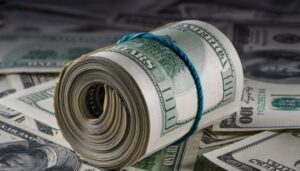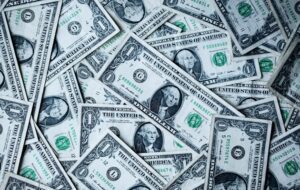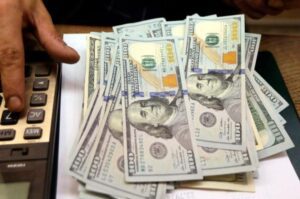
The US dollar is getting cheaper against the euro and the pound sterling during the trading session on Tuesday.
The day before, the U.S. currency steadily strengthened on statements by Federal Reserve (Fed) officials that dampened investor optimism that the rate hike cycle may end soon.
Fed Vice Chair Lale Brainard told Bloomberg on Monday that the Fed is likely to slow the pace of rate hikes soon.
“However, I think it’s important to emphasize: we’ve done a lot already, but we still have more work to do,” Brainard said.
Earlier Monday, her colleague Christopher Waller, a member of the Fed’s board of governors, warned investors against overly optimistic about the timing of the end of the policy tightening cycle, noting that the Fed still has much work to do.
“We have a long, very long way to go to slow inflation. The rate will continue to rise, and it will stay high for a while, until we see it get closer to our target level,” Waller said at an event in Sydney hosted by UBS.
The ICE-calculated index, which shows the dollar’s performance against six currencies (euro, Swiss franc, yen, Canadian dollar, pound sterling and Swedish krona), added 0.2% on Tuesday, while the broader WSJ Dollar lost 0.03%.
The euro/dollar pair is trading at $1.0333 as of 9:15 a.m. Ksk, compared to $1.0329 at the close of the previous session. The pound rose to $1.1776, compared to $1.1760 the day before.
The dollar rose to 140.31 yen against 139.88 yen at the close of previous trading.
The exchange rate of the U.S. currency paired with the yuan dropped to 7.0491 yuan against 7.0740 yuan the day before. On Tuesday, the People’s Bank of China (PBOC, the country’s central bank) injected 850 billion yuan ($120.7 billion) into the financial system as part of its medium-term lending program (MLF).

The National Bank of Ukraine’s net sales of dollars this week decreased to $295.0mn from $393.9mn a week earlier.
According to the National Bank on its website, it bought $31.5 million from November 7 to 11, which is markedly more than the usual volume of purchases during the war ($7-8 million), while it sold $326.5 million, compared to $410.2 million a week earlier.
On the cash market, the hryvnia weakened by about 0.2 UAH per week, to about UAH 40.55/$1. However, the spread between the buying and selling rates remains narrow.
In October, the volume of interventions of the National Bank amounted to $2.03 billion, compared to $2.75 billion in September, $1.33 billion in August and $1.2 billion in July, and remains much less than in June ($3.96 billion) and May ($3.4 billion).
In total, since the beginning of the year to November 11 inclusive, the NBU bought $3 billion 210.8 million and EUR111.0 million in the market, while it sold $22 billion 244.8 million and EUR1 billion 789.1 million.
Since the beginning of the war the purchase of currency reached $2 billion 553.9 million and EUR111.0 million, while the sale reached $19 billion 474.6 million and EUR1 billion 789.1 million.
Ukraine’s international reserves as of November 1, 2022, according to the NBU, amounted to $25 billion 244.2 million (in equivalent), which is 5.5% more than at the beginning of October.

Gold prices are rising in trading on Friday, continuing to rise after rising to the highest since August the day before.
Market is supported by hopes for a possible slowdown in the pace of tightening of monetary policy by the U.S. Federal Reserve (Fed) in December, which put pressure on the dynamics of the dollar, writes MarketWatch.
Prices of December contracts for gold on the New York Mercantile Exchange (NYMEX) rose by 0.46% to $ 1761.7 per troy ounce by 16:39 kcd. Gold is near its highest level since August.
The ICE U.S. Dollar index, which tracks the dollar’s performance against six major world currencies, is down about 1% in trading. The day before it was down 2 percent.
As it became known on Thursday, consumer prices (CPI) in the United States rose by 7.7% in October against the same month last year after an increase of 8.2% in September. Thus, inflation slowed to its lowest since January and was well below market forecasts.
The data may affect the policy of the U.S. Federal Reserve (Fed), which is aggressively raising interest rates in an attempt to curb inflation.
At the same time, prices for other precious metals showed no unified dynamics on Friday.
Silver for December delivery was down 1 percent at $21.5 an ounce.
Palladium prices rose 2.7% to $2007.5 an ounce and platinum fell 0.5% to $1049.3 an ounce.

The exchange rate of US dollar weakly changes on Wednesday morning against major world currencies as investors await the outcome of the mid-term elections to the U.S. Congress.
The ICE index which shows the trend of the US dollar against six currencies (euro, Swiss franc, yen, Canadian dollar, British pound and Swedish krona) is growing by less than 0.1%. Over the past three sessions, the indicator has fallen nearly 3%.
The euro/dollar pair was trading at $1.0073 by 7:55 a.m. qtr. versus $1.0075 at the close of Tuesday’s session.
The dollar/yen is up less than 0.1% at 145.77 yen from 145.69 yen at the end of last session.
The pound is trading at $1.1541, up from $1.1546 at the close of previous trading.
The Republican Party is expected to outperform Democrats in the midterm elections for U.S. Congress, according to U.S. media forecasts. According to CNN’s preliminary forecast, Republicans hold 176 seats in the U.S. House of Representatives, while Democrats have 121 seats. Politico predicts 158 seats for Republicans and 99 for Democrats. One party needs 218 seats out of 435 to control the House of Representatives.
In the Senate election, CNN and Politico predict that Republicans and Democrats are tied at 46 seats each. Republicans need 51 seats to control the Senate – with Vice President Kamala Harris, who is from the Democratic Party, having the right to vote in controversial situations.
In addition, market participants are waiting for data on October inflation in the U.S., which may influence the Fed’s decision. The report will be released Thursday, and analysts polled by Trading Economics on average expect it to point to a slowdown in inflation in October to 8% from September’s 8.2%.
Meanwhile, the mainland yuan gained 0.1% to 7.2445 per $1, while the offshore yuan, which is traded in Hong Kong, strengthened 0.2% to 7.2459 per $1.
China’s inflation slowed in October to its lowest level since May, we learned Wednesday. Consumer prices (CPI) rose 2.1 percent year on year last month after climbing 2.8 percent in September, while analysts on average had expected a more moderate slowdown to 2.4 percent.
Compared with the previous month, consumer prices in the PRC rose 0.1% in October after rising 0.3% a month earlier. Experts predicted that the growth rate would remain at the September level.

The dollar showed moderate gains against major world currencies Monday morning.
The ICE-calculated index, which shows the U.S. dollar against six currencies (euro, Swiss franc, yen, Canadian dollar, pound sterling and Swedish krona), is up about 0.1%. The broader WSJ Dollar Index is up 0.2%.
The euro/dollar pair is trading at $0.9950 by 7:45 a.m. Q, versus $0.9960 at the close of last Friday’s session, the euro is losing about 0.1%.
The dollar/yen is up 0.3% at 147.08 yen from 146.62 yen at the end of last week.
The pound is trading at $1.1333, up from $1.1377 at the close of the previous session.
Currency traders continue to try to predict the future trajectory of Federal Reserve interest rates. Currently, the market generally expects the Fed to slow the rate hike in December and raise it by 50 basis points after raising it by 75 bps at four previous meetings, Trading Economics writes.
In addition, market participants are waiting for data on October inflation in the U.S., which may affect the Fed’s decision. The report will be released Thursday, and analysts polled by Trading Economics on average expect it to point to a slowdown in inflation in October to 8% from September’s 8.2%.
Meanwhile, the mainland yuan is down 0.4% to 7.2119 per $1, and the offshore yuan, which is traded in Hong Kong, is down 0.54% to 7.2154 per $1.
The Wall Street Journal wrote last Friday, citing several sources, that Zeng Guang, a former top epidemiologist at China’s Center for Disease Control and Prevention, said during a conference that a major change in the country’s approach to the coronavirus pandemic was expected in 2023.
Over the weekend, however, Beijing reiterated its intention to adhere “rigorously” to a “zero tolerance” policy for COVID-19.
“Previous practices have shown that our prevention and control plans, as well as a series of strategic measures, have been absolutely correct,” Bloomberg quoted CDCP official Hu Xiang as saying.

Since October 21, Ukrainians have opened 2.5 thousand deposits with the purchase of dollars at the official rate of the National Bank of Ukraine (NBU) for a period of 6 months, followed by the mandatory sale also at the official rate, the NBU press service reported on Friday.
According to the release, the average deposit amount is $3.6 thousand, and the total amount attracted as of November 1 on such deposits amounted to $9 million.
“The NBU does not have targets for attracting such deposits by banks. Our goal is to stabilize and improve exchange rate expectations, reduce pressure on the hryvnia cash exchange rate and protect international reserves,” the press service of the head of the monetary policy department of the department of monetary policy and economic analysis of the National Bank Mikhail Rebrika.
As reported, since October 21, the NBU, in cooperation with banks, has allowed individuals to buy US dollars at the official NBU rate, followed by their placement on a fixed-term deposit in a bank and the mandatory resale of the purchased currency upon the expiration of the deposit at the official rate.
According to the report, the amount and number of such deposits for one client of the bank are not limited, and the interest rate on the deposit will be set in accordance with the interest rate policy of banks, the deposit term is from six months with the possibility of prolongation, but without the right of early termination.
Earlier, from July 21, the National Bank allowed the purchase of non-cash currency at commercial rates to place it on deposit for at least three months, but without the obligation to sell such currency upon completion of the deposit. At the same time, the volume of such deposits was initially limited to UAH 50,000, and recently the ceiling was raised to UAH 100,000 per month.